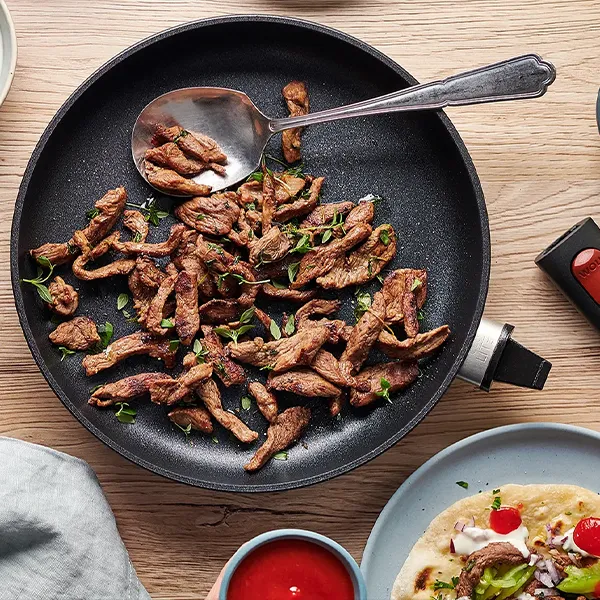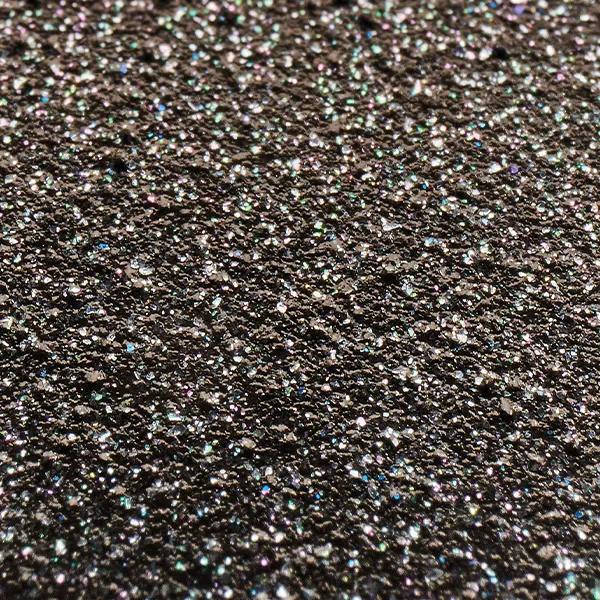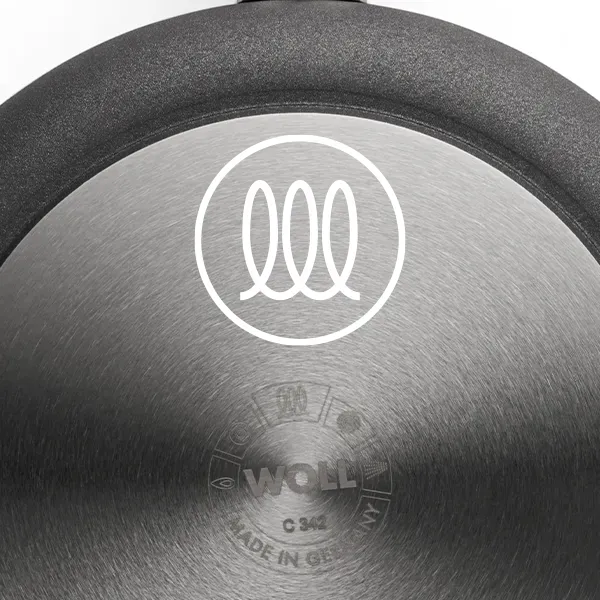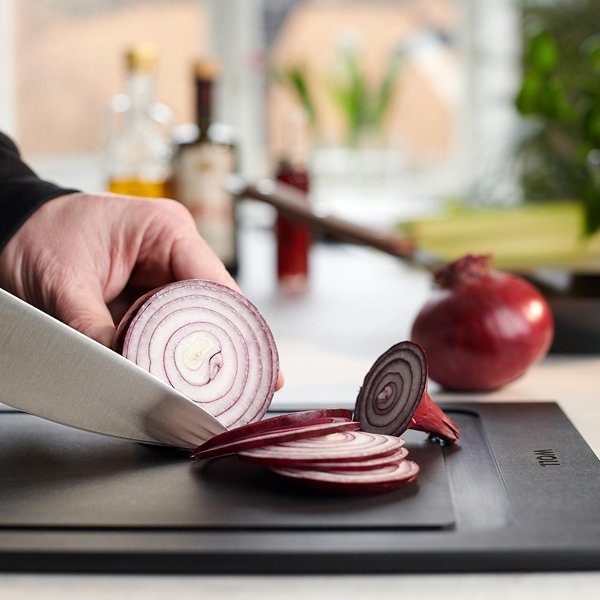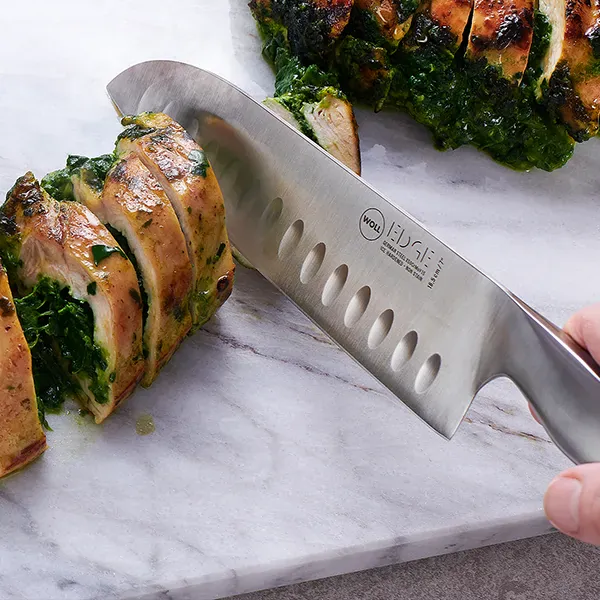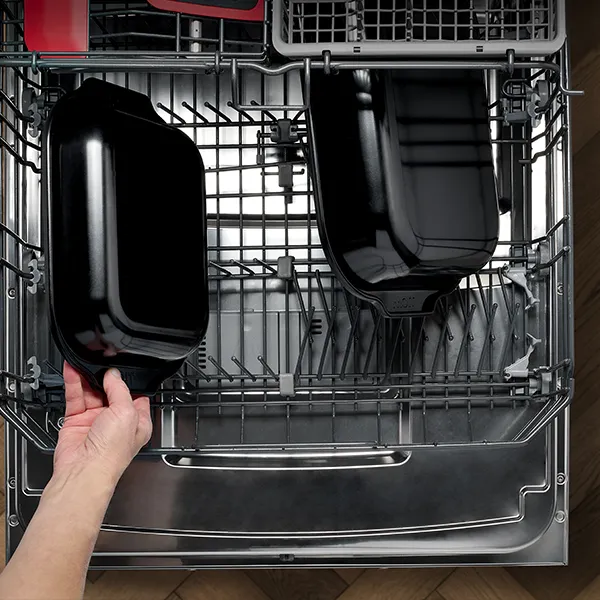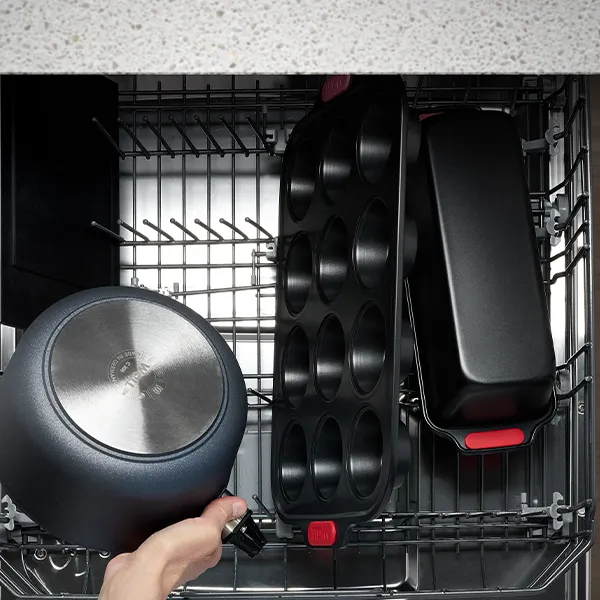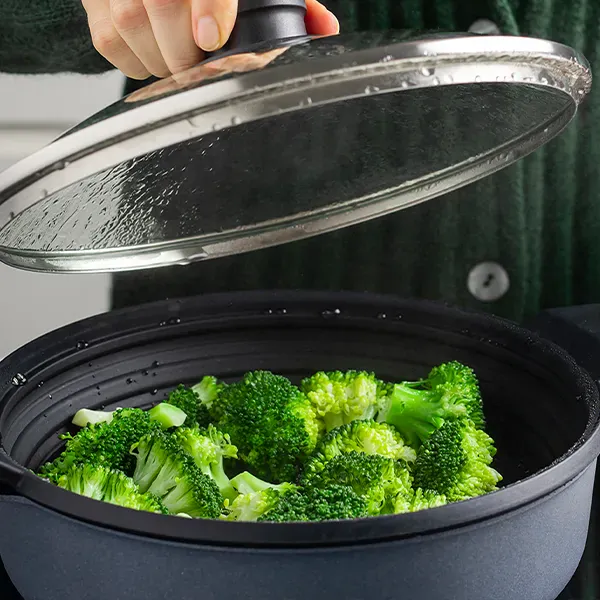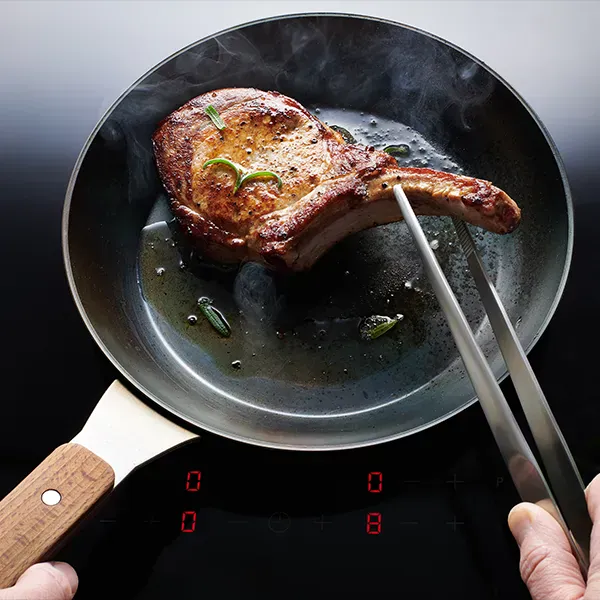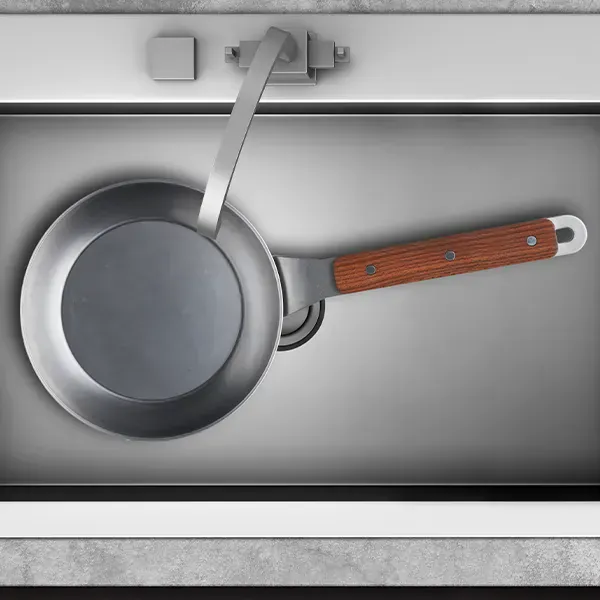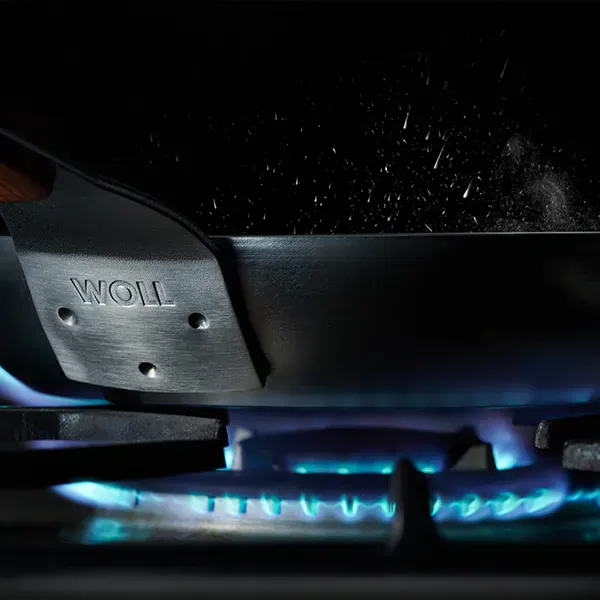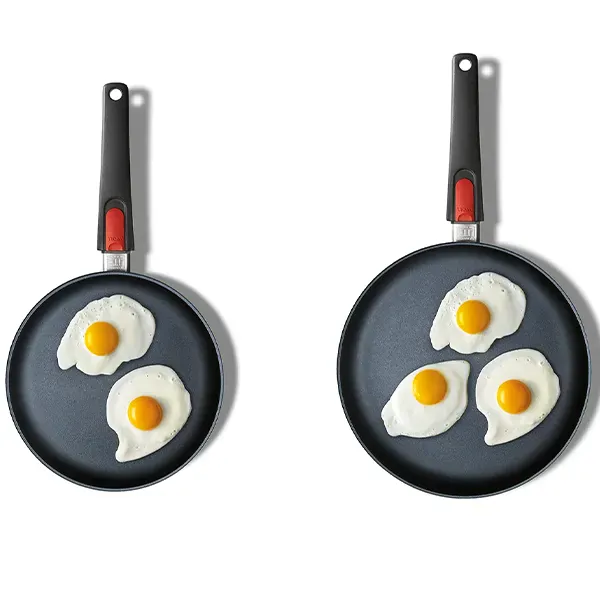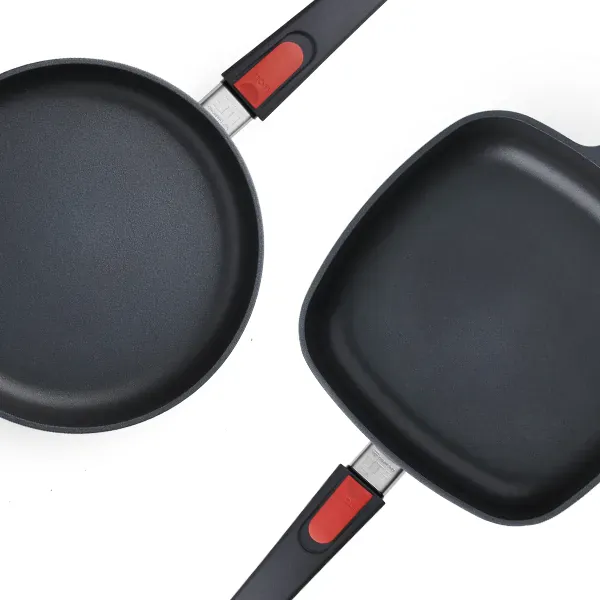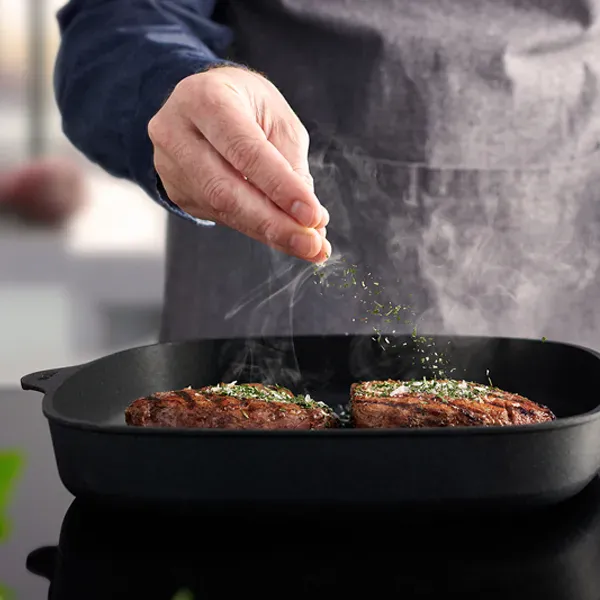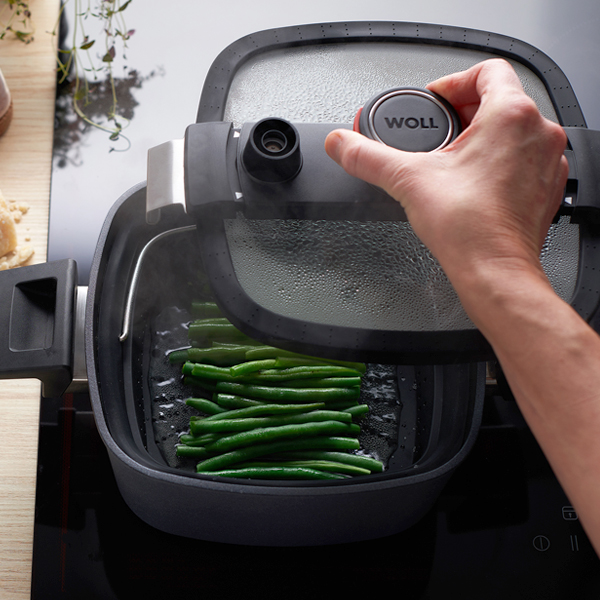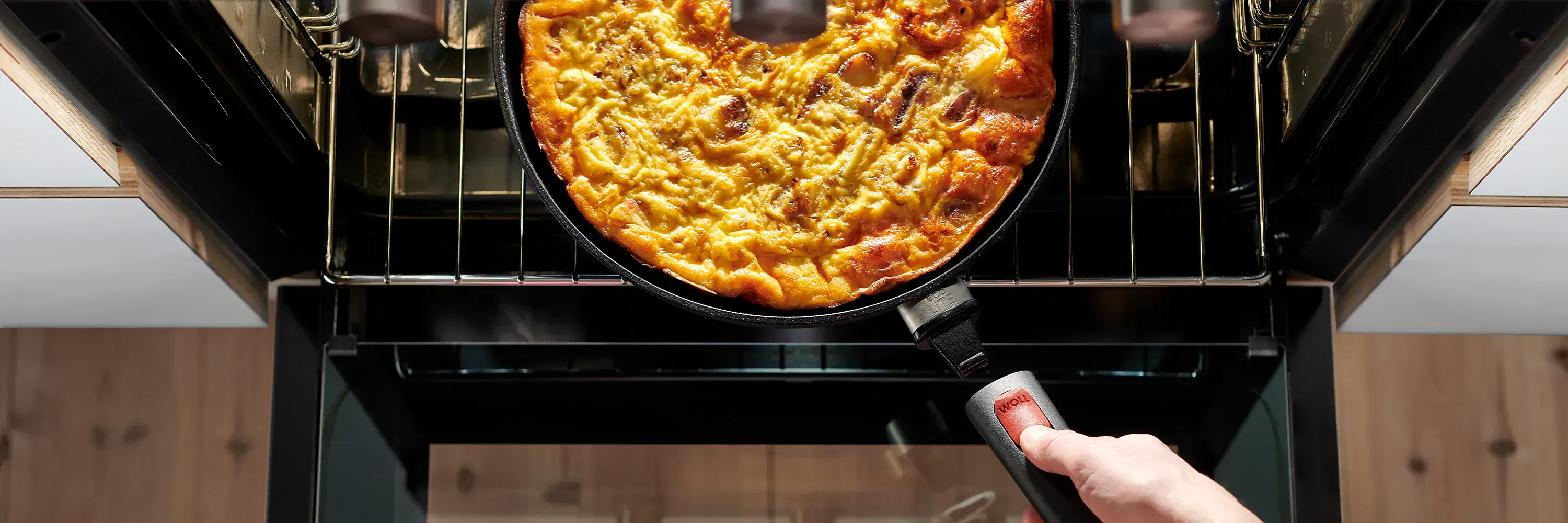

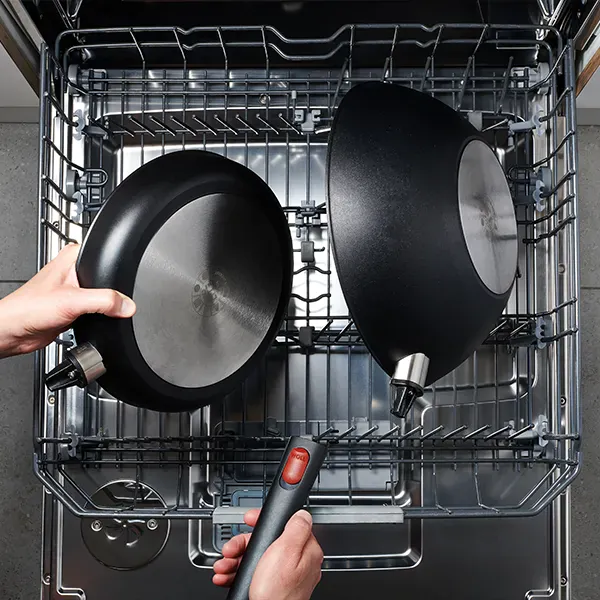
Cast products from WOLL heat up particularly quickly. Fats and oils have different smoke points. To protect your product from burnt-on fat, you should add your oil to the cold pan and only then turn up the temperature. If the oil starts to sizzle when you add your food, it is at the ideal temperature (the dry handle of a wooden spoon can also be used to test the oil).
After each use, your cookware should either be cleaned by hand with washing-up liquid and a kitchen sponge or in the dishwasher to remove any grease residue. This protects the coating from burnt-on grease. If possible, wash your cookware by hand more often - as this method is particularly gentle on the material, you will enjoy your cookware for a particularly long time.
When cleaning in the dishwasher, please note: the dishwasher salts can cause discolouration on the base of non-inductive products. However, this does not affect the frying properties in any way.
All induction hobs have a so-called booster function, which enables an enormous increase in the power of the hob over a short period of time. However, special care must be taken when using this function, especially to heat up the cookware quickly: to prevent damage to the sealing, the hob should be switched off again after using the booster function for one minute at the latest.
Thanks to the unique cut and abrasion-resistant WOLL hard base coating, all kitchen utensils can be used without any problems - whether made of wood, plastic, silicone or stainless steel. Small scratches do not affect the performance or longevity of the cookware.

Please note the following for your cast iron cookware: in general, you should not place hot cookware under cold water - it is better to let it cool down completely before cleaning. After cleaning, your cast iron product must always be allowed to dry thoroughly. The best way to do this is to heat the empty product on the hob for a short time under supervision until it is completely dry. You should then rub the top edge and the edge of the lid with a little cooking oil.

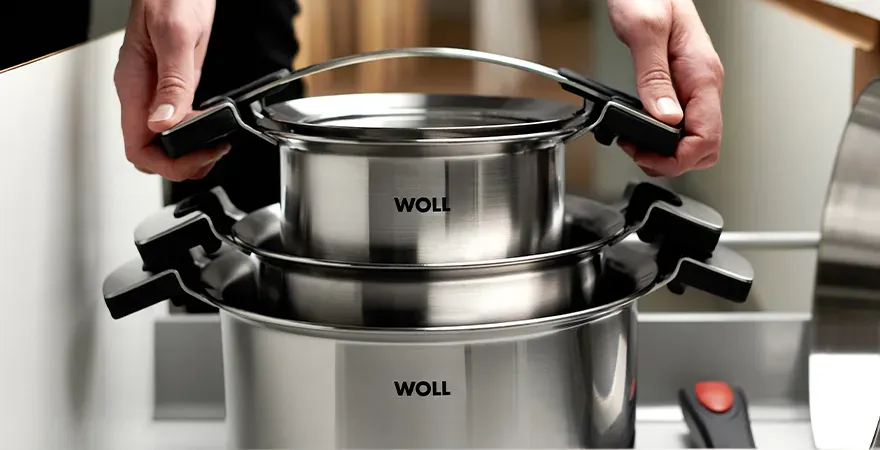
All our stainless steel cookware is made of 18/10 stainless steel. This material contains around 10% nickel, which makes the material rustproof and food-safe. Stainless steel cookware is therefore unsuitable for people with an allergy to nickel - but it is safe to use if you are intolerant to cobalt.
If stainless steel is heated to high temperatures, rainbow-coloured stains can form in the material. These do not affect the performance and longevity of the cookware in any way - but if you still want to remove them, this household remedy can help:
Salt stains on your stainless steel cookware are caused by "hard" tap water, so they are actually calcium or other mineral deposits that are neither harmful to your health nor affect the performance of your cookware. A simple household remedy can help to remove these blemishes: Vinegar essence.
To avoid salt stains from the outset, you should always clean your stainless steel cookware promptly after cooking and then dry it immediately. Washing by hand is even gentler on your cookware.
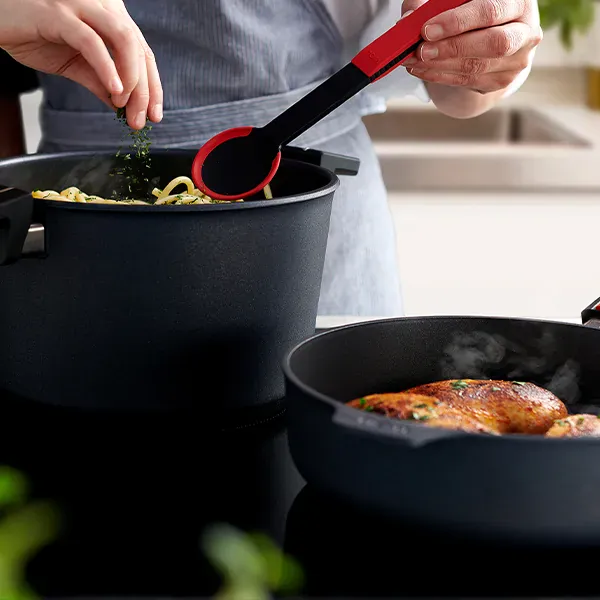
How to use and care for your cast aluminium cookware optimally
Please boil your WOLL product three times before using it for the first time.
You can also watch this video to find out how to boil your product properly before using it for the first time:
All induction hobs have a so-called booster function, which enables an enormous increase in the power of the hob over a short period of time. However, special care must be taken when using this function, especially to heat up the cookware quickly: to prevent damage to the sealing, the hob should be switched off again after using the booster function for two minutes at the latest.
WOLL cast iron products heat up particularly quickly. Fats and oils have different smoke points. To protect your product from burnt-on fat, you should add your oil to the cold pan and only then turn up the temperature. If the oil starts to sizzle when you add your food, it is at the ideal temperature (the dry handle of a wooden spoon can also be used to test the oil).
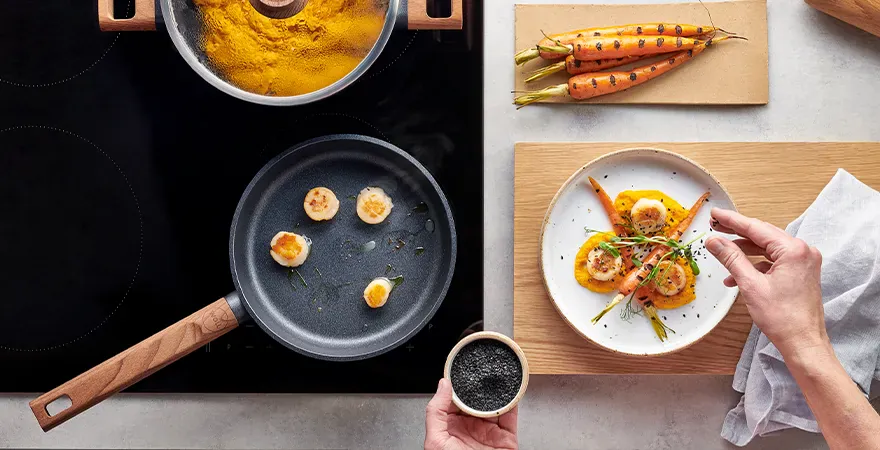
When sliding the pan on the hob, dirt particles that get between the base of the cookware and the hob can scratch the hob. You should therefore always lift your product when moving it.
Thanks to the unique cut and abrasion-resistant WOLL hard base coating, all kitchen utensils can be used without any problems - whether made of wood, plastic, silicone or stainless steel. Small scratches do not affect the performance or longevity of the cookware.
After each use, the product should either be cleaned by hand with washing-up liquid and a kitchen sponge or cleaned in the dishwasher to remove grease residues. This protects the coating from burnt-on grease. The dishwasher salts can cause discolouration on the base of non-inductive products. However, this does not affect the frying properties in any way.

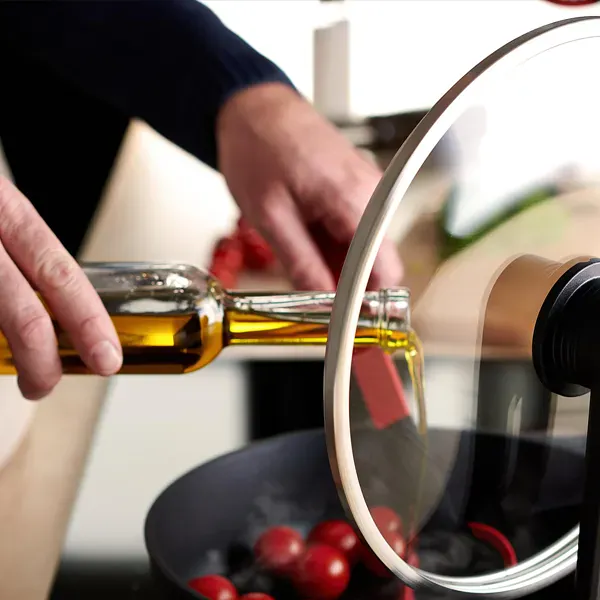
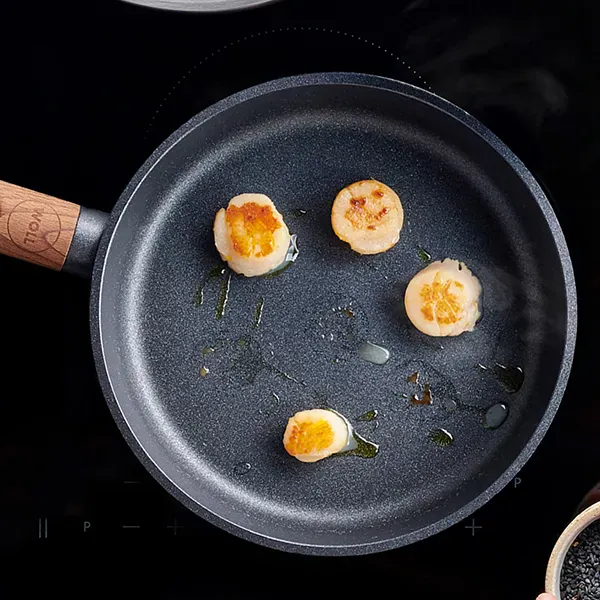
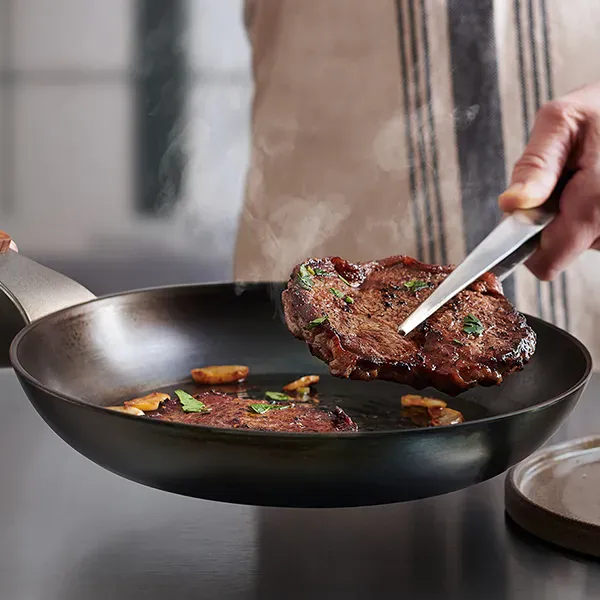




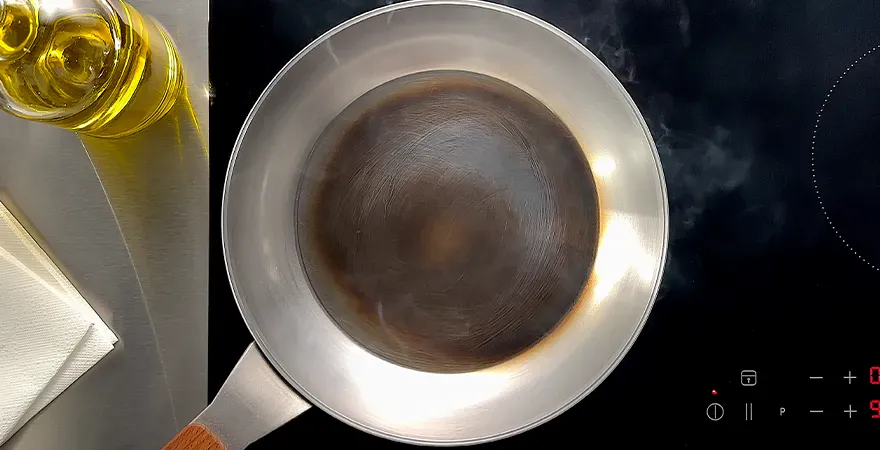
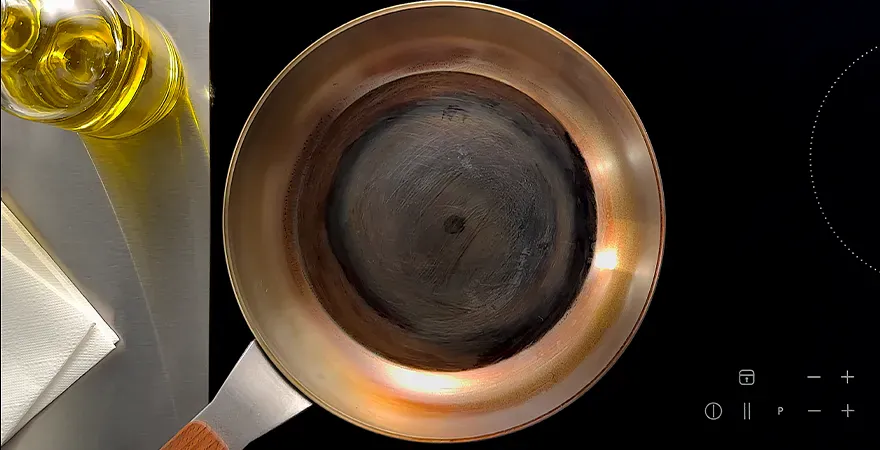
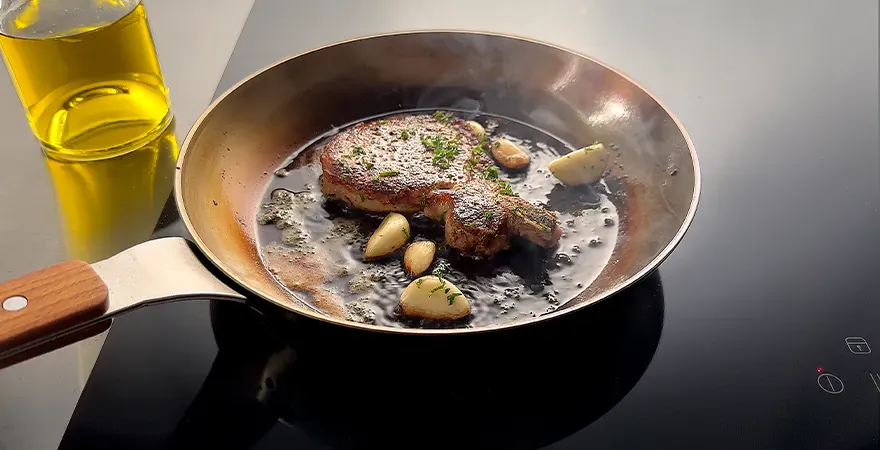
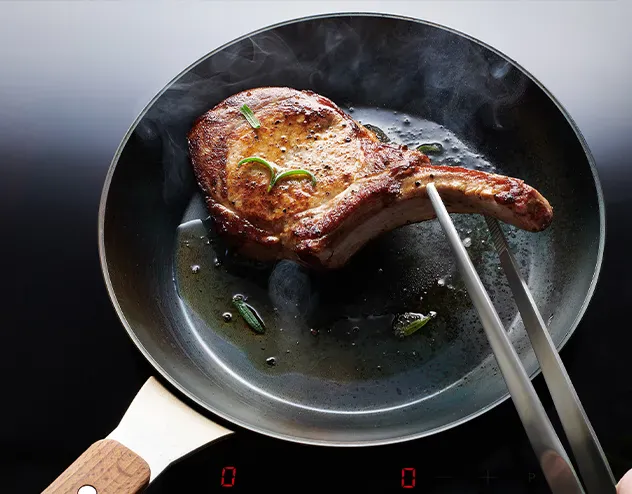
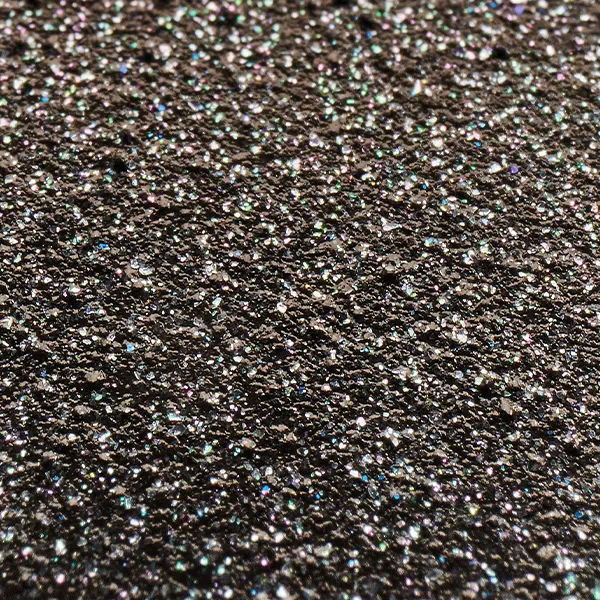
PFAS. This subject is currently occupying the public - but it has occupied us for much longer. PFAS belong to a group of chemicals that have upsides and downsides. The upsides? They provide an unprecedented non-stick effect, and they're harmless in use. That's very helpful when used in medical products and clothing. And, of course, in cookware, too, as it prevents food from sticking to pans or pots. The downsides? PFAS are almost impossible to degrade, which is why they're also called Forever Chemicals. And in high concentrations, they can make you ill. For us, this is reason enough to develop an alternative that combines all the advantages of PFAS - but has none of the disadvantages. QXR. The revolution with three letters. Our competitors use simple ceramic coatings for their PFAS-free cookware - with a rather average performance. However, average and Woll don't fit together. So, we developed something entirely groundbreaking. And we call it QXR.
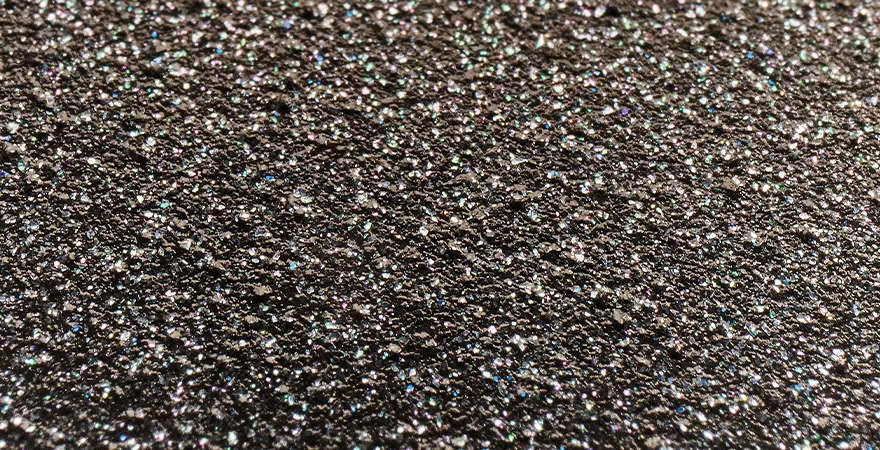
Extremely tough. Extremely rough. Extremely Woll. QXR is an exceptionally hard finish made from natural quartzite. It is in no way inferior to the non-stick effect of cookware with PFAS. Combined with Woll's typical embedded diamond crystals, the new QXR series additionally achieve unparalleled ruggedness. And the ultra-rough surface, which is exclusive to Woll, creates roasting aromas that make dishes so special. After all, taste must not be neglected.
We've been working on our Eco Lite and Eco Logic series with Diamond QXR sealing for a long time. Because we always take our time to build products of the highest quality.
At Woll, we always think one step ahead. Doing it differently. Doing it better. - that's our philosophy. And the unconditional will to optimize is an ongoing process. Now that you can hold our latest series in your hands, we're already back at work - developing the next innovation. You can look forward to it!
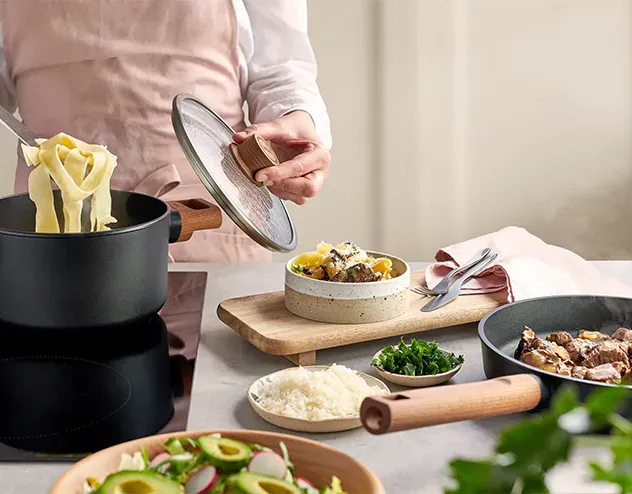
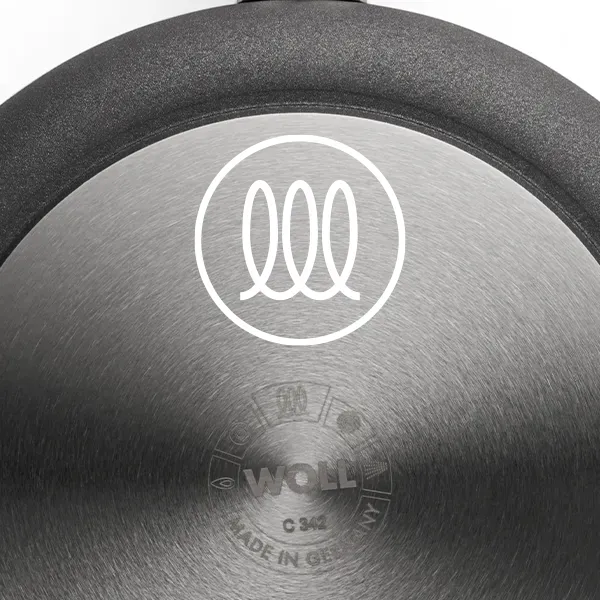
Modern induction hobs offer a very special cooking experience. Induction hobs have magnetic coils installed under the glass ceramic, which generate a strong magnetic field directly in the base of the induction product. This energy is very quickly converted into heat in the induction base. The heat is therefore generated exactly where it is needed - in the cookware - and not on the hob.
At WOLL, we have made it our mission to develop cookware that has been thought through down to the last detail. Our induction products are no exception: A full-surface induction base made of special ferromagnetic steel is the centrepiece of our induction pans. Specially developed by WOLL, it ensures a magnetic field of optimum strength and its best possible transfer to the pan. The approx. 9 mm thick base also lies absolutely flat, which is a prerequisite for optimum energy transfer.

Induction hobs heat food much faster and more precisely than conventional appliances. This saves time and money.
Burnt-on splashes and sauce stains are a thing of the past. With induction, the surface around the pan remains cold. Stains can therefore be removed easily.
The heat is generated directly and evenly by magnetism in the full-surface induction base, which heats the pan quickly and precisely. This saves energy

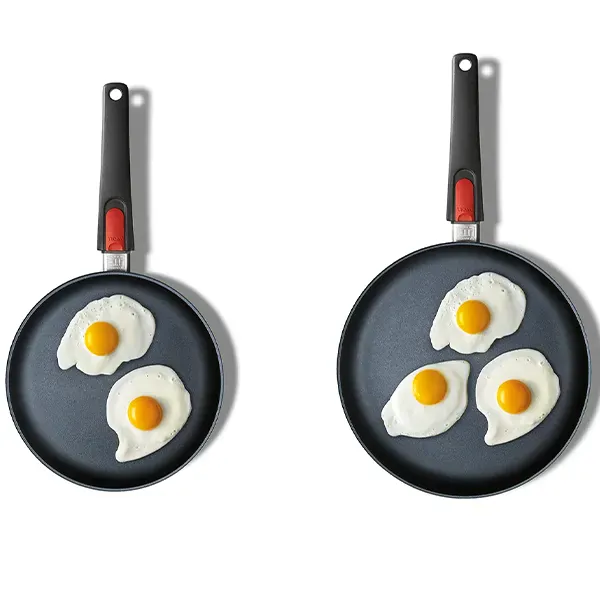
The choice of pan depends on what you are cooking - and for how many people. 24 cm diameter or would you prefer 28 cm? Round or square? You can easily see from this chart which pan size suits your cooking habits:



You may have already noticed: many of our pans are available in round and square versions. Each shape has its own advantages; for example, dishes with a lot of sauce can be easily stirred with the flick of a wrist in round pans. On the other hand, our square pans of a similar size have around 30 % more capacity, perfect for larger appetites. By the way: the induction base of our pans is round on all models and therefore fits securely on your round hobs.
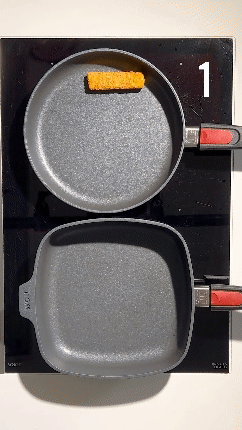
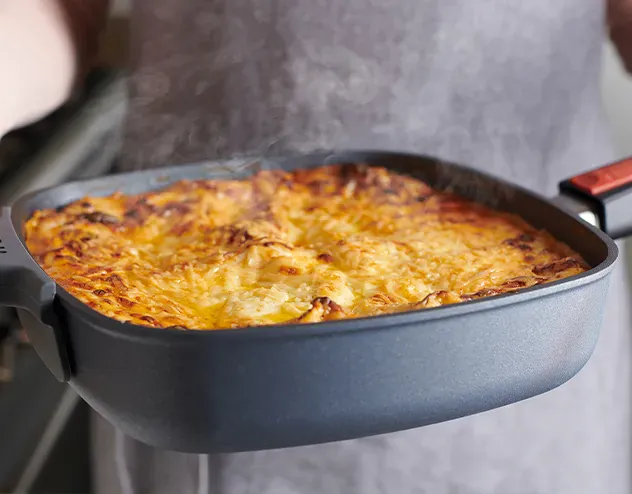

Ingredients:
The meat should be at room temperature before searing and taken out of the fridge approx. 2 hours before eating.

Tip: FFor even more flavour, the steaks can be rubbed with garlic and/or olive oil before searing. The cooking stages at a glance (for 3.5-4 cm thick steaks): Rare (approx. 2 minutes and 20 seconds on each side): Almost raw and still a little rare on the inside. Medium rare (approx. 3 minutes and 20 seconds on each side): Nice and juicy on the inside and nicely browned on the outside. Medium (approx. 4 minutes and 20 seconds from each side): Pink on the inside and dark brown crust. Well-done: Fully cooked steak.
We used:
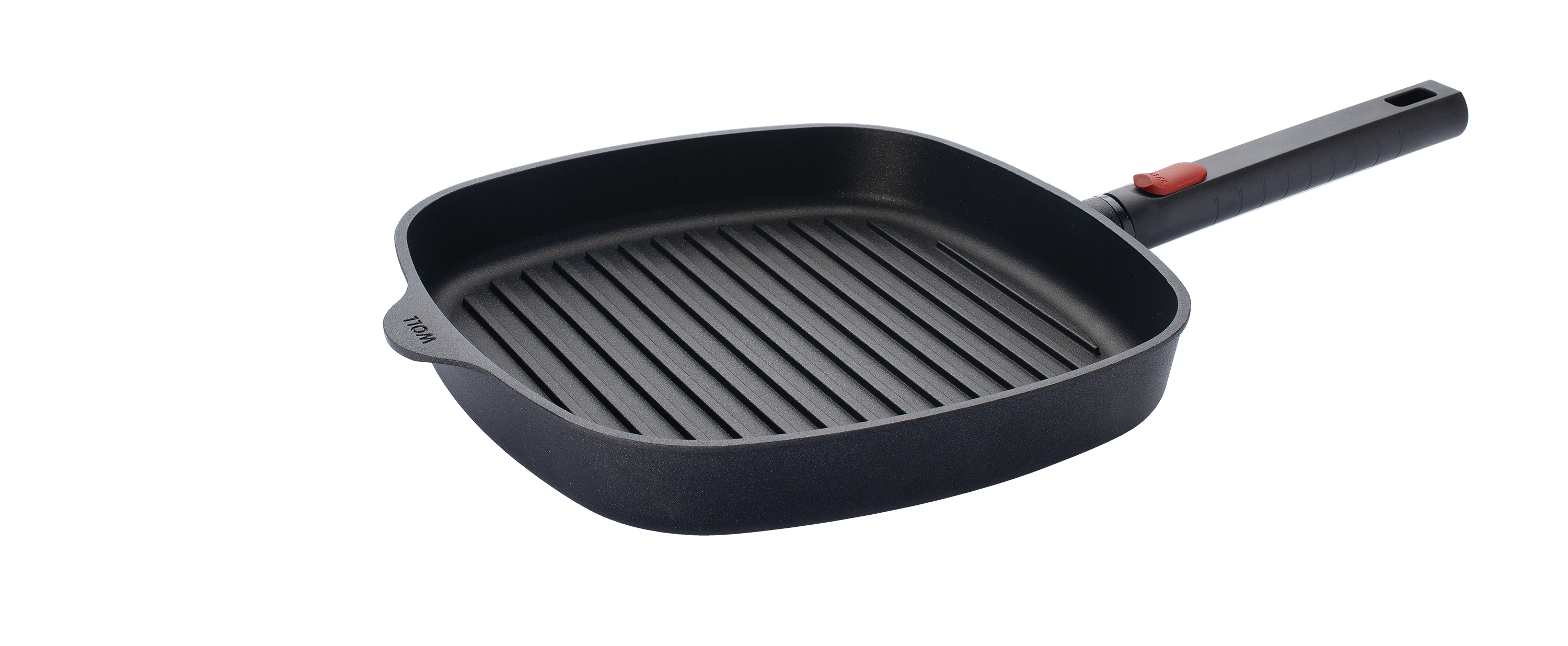




Cast products from WOLL heat up particularly quickly. Fats and oils have different smoke points. To protect your product from burnt-on fat, you should add your oil to the cold pan and only then turn up the temperature. If the oil starts to sizzle when you add your food, it is at the ideal temperature (the dry handle of a wooden spoon can also be used to test the oil).
After each use, your cookware should either be cleaned by hand with washing-up liquid and a kitchen sponge or in the dishwasher to remove any grease residue. This protects the coating from burnt-on grease. If possible, wash your cookware by hand more often - as this method is particularly gentle on the material, you will enjoy your cookware for a particularly long time.
When cleaning in the dishwasher, please note: the dishwasher salts can cause discolouration on the base of non-inductive products. However, this does not affect the frying properties in any way.
All induction hobs have a so-called booster function, which enables an enormous increase in the power of the hob over a short period of time. However, special care must be taken when using this function, especially to heat up the cookware quickly: to prevent damage to the sealing, the hob should be switched off again after using the booster function for one minute at the latest.
Thanks to the unique cut and abrasion-resistant WOLL hard base coating, all kitchen utensils can be used without any problems - whether made of wood, plastic, silicone or stainless steel. Small scratches do not affect the performance or longevity of the cookware.

Please note the following for your cast iron cookware: in general, you should not place hot cookware under cold water - it is better to let it cool down completely before cleaning. After cleaning, your cast iron product must always be allowed to dry thoroughly. The best way to do this is to heat the empty product on the hob for a short time under supervision until it is completely dry. You should then rub the top edge and the edge of the lid with a little cooking oil.


All our stainless steel cookware is made of 18/10 stainless steel. This material contains around 10% nickel, which makes the material rustproof and food-safe. Stainless steel cookware is therefore unsuitable for people with an allergy to nickel - but it is safe to use if you are intolerant to cobalt.
If stainless steel is heated to high temperatures, rainbow-coloured stains can form in the material. These do not affect the performance and longevity of the cookware in any way - but if you still want to remove them, this household remedy can help:
Salt stains on your stainless steel cookware are caused by "hard" tap water, so they are actually calcium or other mineral deposits that are neither harmful to your health nor affect the performance of your cookware. A simple household remedy can help to remove these blemishes: Vinegar essence.
To avoid salt stains from the outset, you should always clean your stainless steel cookware promptly after cooking and then dry it immediately. Washing by hand is even gentler on your cookware.
How to use and care for your cast aluminium cookware optimally
Please boil your WOLL product three times before using it for the first time.
You can also watch this video to find out how to boil your product properly before using it for the first time:
All induction hobs have a so-called booster function, which enables an enormous increase in the power of the hob over a short period of time. However, special care must be taken when using this function, especially to heat up the cookware quickly: to prevent damage to the sealing, the hob should be switched off again after using the booster function for two minutes at the latest.
WOLL cast iron products heat up particularly quickly. Fats and oils have different smoke points. To protect your product from burnt-on fat, you should add your oil to the cold pan and only then turn up the temperature. If the oil starts to sizzle when you add your food, it is at the ideal temperature (the dry handle of a wooden spoon can also be used to test the oil).

When sliding the pan on the hob, dirt particles that get between the base of the cookware and the hob can scratch the hob. You should therefore always lift your product when moving it.
Thanks to the unique cut and abrasion-resistant WOLL hard base coating, all kitchen utensils can be used without any problems - whether made of wood, plastic, silicone or stainless steel. Small scratches do not affect the performance or longevity of the cookware.
After each use, the product should either be cleaned by hand with washing-up liquid and a kitchen sponge or cleaned in the dishwasher to remove grease residues. This protects the coating from burnt-on grease. The dishwasher salts can cause discolouration on the base of non-inductive products. However, this does not affect the frying properties in any way.













PFAS. This subject is currently occupying the public - but it has occupied us for much longer. PFAS belong to a group of chemicals that have upsides and downsides. The upsides? They provide an unprecedented non-stick effect, and they're harmless in use. That's very helpful when used in medical products and clothing. And, of course, in cookware, too, as it prevents food from sticking to pans or pots. The downsides? PFAS are almost impossible to degrade, which is why they're also called Forever Chemicals. And in high concentrations, they can make you ill. For us, this is reason enough to develop an alternative that combines all the advantages of PFAS - but has none of the disadvantages. QXR. The revolution with three letters. Our competitors use simple ceramic coatings for their PFAS-free cookware - with a rather average performance. However, average and Woll don't fit together. So, we developed something entirely groundbreaking. And we call it QXR.

Extremely tough. Extremely rough. Extremely Woll. QXR is an exceptionally hard finish made from natural quartzite. It is in no way inferior to the non-stick effect of cookware with PFAS. Combined with Woll's typical embedded diamond crystals, the new QXR series additionally achieve unparalleled ruggedness. And the ultra-rough surface, which is exclusive to Woll, creates roasting aromas that make dishes so special. After all, taste must not be neglected.
We've been working on our Eco Lite and Eco Logic series with Diamond QXR sealing for a long time. Because we always take our time to build products of the highest quality.
At Woll, we always think one step ahead. Doing it differently. Doing it better. - that's our philosophy. And the unconditional will to optimize is an ongoing process. Now that you can hold our latest series in your hands, we're already back at work - developing the next innovation. You can look forward to it!

Modern induction hobs offer a very special cooking experience. Induction hobs have magnetic coils installed under the glass ceramic, which generate a strong magnetic field directly in the base of the induction product. This energy is very quickly converted into heat in the induction base. The heat is therefore generated exactly where it is needed - in the cookware - and not on the hob.
At WOLL, we have made it our mission to develop cookware that has been thought through down to the last detail. Our induction products are no exception: A full-surface induction base made of special ferromagnetic steel is the centrepiece of our induction pans. Specially developed by WOLL, it ensures a magnetic field of optimum strength and its best possible transfer to the pan. The approx. 9 mm thick base also lies absolutely flat, which is a prerequisite for optimum energy transfer.

Induction hobs heat food much faster and more precisely than conventional appliances. This saves time and money.
Burnt-on splashes and sauce stains are a thing of the past. With induction, the surface around the pan remains cold. Stains can therefore be removed easily.
The heat is generated directly and evenly by magnetism in the full-surface induction base, which heats the pan quickly and precisely. This saves energy

The choice of pan depends on what you are cooking - and for how many people. 24 cm diameter or would you prefer 28 cm? Round or square? You can easily see from this chart which pan size suits your cooking habits:




You may have already noticed: many of our pans are available in round and square versions. Each shape has its own advantages; for example, dishes with a lot of sauce can be easily stirred with the flick of a wrist in round pans. On the other hand, our square pans of a similar size have around 30 % more capacity, perfect for larger appetites. By the way: the induction base of our pans is round on all models and therefore fits securely on your round hobs.


Ingredients:
The meat should be at room temperature before searing and taken out of the fridge approx. 2 hours before eating.

Tip: For even more flavour, the steaks can be rubbed with garlic and/or olive oil before searing. The cooking stages at a glance (for 3.5-4 cm thick steaks): Rare (approx. 2 minutes and 20 seconds on each side): Almost raw and still a little rare on the inside. Medium rare (approx. 3 minutes and 20 seconds on each side): Nice and juicy on the inside and nicely browned on the outside. Medium (approx. 4 minutes and 20 seconds from each side): Pink on the inside and dark brown crust. Well-done: Fully cooked steak.
We used:







